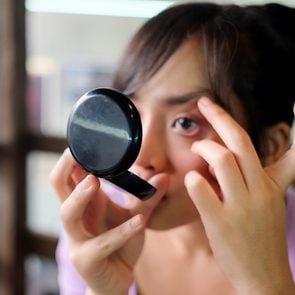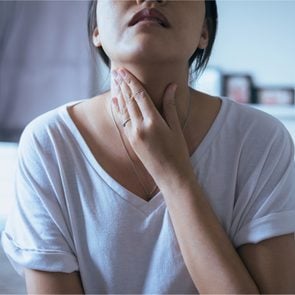What Was Eating Away at This Young Woman’s Sternum?

27-year-old Amber was worried her chest pain was a sign of cancer. What the MRI revealed threw her—and her doctor—for a loop.
Amber, a 27-year-old ESL tutor (identifying details have been changed),is adventurous and loves to travel, but COVID-19 put all her plans on hold. She spent most of the summer of 2020 at her home in Phoenix, Arizona, with her two kittens. In early July of that year, her lower back started to hurt—a return, Amber thought, of a chronic problem she’d dealt with years before. Then she started feeling pain in the front of her chest that flared up whenever she moved. She was also sweating in her sleep, waking up soaked in the middle of the night. She initially blamed it on the Arizona climate. But as the weeks went by, her discomfort worsened.
Could it be a tumour?
In August 2020, Amber found a hard, swollen lump in the upper area of her sternum, or breastbone. When she asked her physician friends about it, their responses were carefully neutral. “I knew that meant it could be something bad,” she says. Worried it was a tumour, she finally made an appointment with her doctor. A chest X-ray revealed signs of inflammation in her sternum, and blood work showed high inflammatory markers. An injury or infection could cause these test results; so could the cancer Amber feared. Her doctor scheduled an MRI for a better picture of what was going on.
While Amber waited two weeks for the MRI appointment, the soreness made breathing difficult. Simple tasks became almost impossible. “Leaning over to tie my shoes caused pain in my chest and back,” she says. “It was immobilizing me.” She steeled herself for the news that she had some kind of malignant mass, but the MRI instead showed that something, likely bacteria, was eating away at the bone in a sternum joint. Amber was at risk of sepsis, a life-threatening reaction to an untreated bacterial infection.
“My grandpa died from sepsis, so I knew it was scary,” she says. Her doctor recommended going to the ER at the local Mayo Clinic for IV antibiotics and a bone biopsy to confirm the infection.
“Is there something we’re missing?”
After looking at Amber’s CT scan, internist Dr. Umesh Sharma expected to see a patient with a badly infected breastbone. He was less certain after he examined her. “Typically, when you have infection in any joint or skin, it gets red, hot, swollen and painful,” he says. “It was painful, but didn’t have the red-hotness. That made us ask, is there something we’re missing?”
Sharma was hesitant to treat for infection if he wasn’t completely sold on the diagnosis. Biopsies involve extracting infected tissue with a needle to verify the infection and identify the type of bacteria—and intravenous antibiotics can last six to eight weeks. Sharma consulted with orthopaedic physicians at the Mayo Clinic. They felt that since the lump wasn’t deep, a biopsy, if needed, could be handled by the interventional radiology department, where doctors perform procedures while taking images.
For Amber, the experience of being the subject of a diagnostic puzzle was unnerving, but she appreciated her doctor’s openness. “Being in the loop was calming,” she says. “Dr. Sharma wanted to make sure I knew what was going on.”
A battery of tests
When a radiologist reviewed Amber’s MRI and CT scans, a few oddities stood out. The patterns of bone destruction weren’t typical of infection—some areas looked thickened—and there weren’t any breaks in the skin where bacteria could have entered the body. Plus, the location of the problem was a clue: It was typical of a rare condition called SAPHO syndrome (SAPHO stands for synovitis, acne, pustulosis, hyperostosis and osteitis), which often causes chronic inflammation and pain in the chest, although it doesn’t normally worsen this quickly.
After the radiologist shared his theory, Sharma postponed the biopsy to run more tests, including for fungal infection, cancer, even tuberculosis. Although there was now a strong possibility Amber had SAPHO syndrome, he didn’t want to fall into the same trap of focusing on one diagnosis. He also turned to the rheumatology team for a different perspective. They suggested scanning other bones in Amber’s body. If she did have an inflammatory condition like SAPHO, it would likely be more widespread.
The new scans proved to be a game-changer. Amber had inflammation and bone erosion in her sacroiliac joints, located between her pelvis and the base of her spine. Finally, there was evidence they weren’t dealing with a localized infection.
A rare diagnosis
In fact, the site of these bone changes pointed to a different condition—ankylosing spondylitis (AS), a form of arthritis that can fuse and stiffen joints. AS is known for attacking the sacroiliac joints and can affect the breastbone as well. AS isn’t usually discovered until young adulthood—perhaps because one of the earliest symptoms, low back pain, is easily dismissed. The cause of AS isn’t fully understood, but a specific gene is known to be a factor. If left untreated, the disease can permanently reduce mobility.
About one in 1,000 people are diagnosed with AS worldwide, making it more common than SAPHO. But since initial tests focused only on Amber’s chest, it hadn’t been on the radar. “Hindsight is 20/20 when you have all the information,” says Sharma.
He ordered a genetic test for AS, and Amber was discharged a couple of days later. In two weeks, the test came back positive; Amber started a drug to slow the disease’s progression. Although AS can’t be cured, she will likely lead a normal life as long as she continues treatment and physical therapy.
The diagnosis has changed Amber’s day-to-day outlook, she says. “I’m a little more in the moment now, more present, and not taking things for granted.” She’s also grateful she avoided the invasive biopsy and weeks of the wrong treatment. “We could have gone down a rabbit hole, and we don’t know what the adverse effects of that could have been.”
Next, read the incredible story of how a woman’s X-ray revealed the reason behind her life-long stomach pain.






